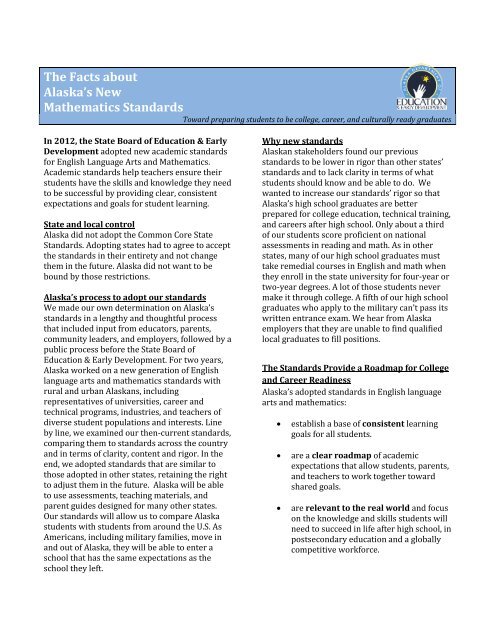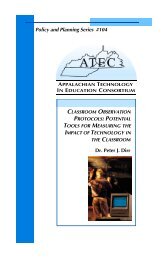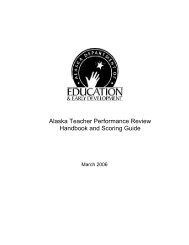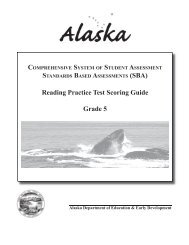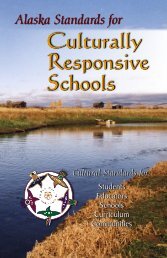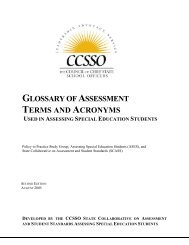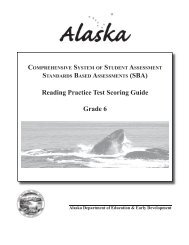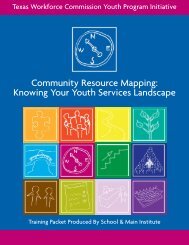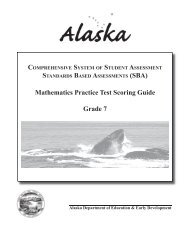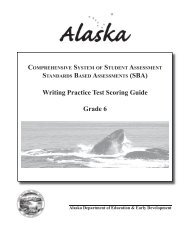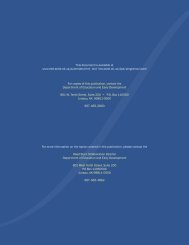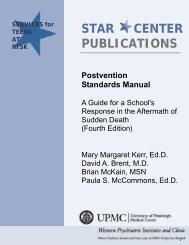Math - Alaska Department of Education & Early Development
Math - Alaska Department of Education & Early Development
Math - Alaska Department of Education & Early Development
You also want an ePaper? Increase the reach of your titles
YUMPU automatically turns print PDFs into web optimized ePapers that Google loves.
The Facts about<strong>Alaska</strong>’s New<strong>Math</strong>ematics StandardsToward preparing students to be college, career, and culturally ready graduatesIn 2012, the State Board <strong>of</strong> <strong>Education</strong> & <strong>Early</strong><strong>Development</strong> adopted new academic standardsfor English Language Arts and <strong>Math</strong>ematics.Academic standards help teachers ensure theirstudents have the skills and knowledge they needto be successful by providing clear, consistentexpectations and goals for student learning.State and local control<strong>Alaska</strong> did not adopt the Common Core StateStandards. Adopting states had to agree to acceptthe standards in their entirety and not changethem in the future. <strong>Alaska</strong> did not want to bebound by those restrictions.<strong>Alaska</strong>’s process to adopt our standardsWe made our own determination on <strong>Alaska</strong>’sstandards in a lengthy and thoughtful processthat included input from educators, parents,community leaders, and employers, followed by apublic process before the State Board <strong>of</strong><strong>Education</strong> & <strong>Early</strong> <strong>Development</strong>. For two years,<strong>Alaska</strong> worked on a new generation <strong>of</strong> Englishlanguage arts and mathematics standards withrural and urban <strong>Alaska</strong>ns, includingrepresentatives <strong>of</strong> universities, career andtechnical programs, industries, and teachers <strong>of</strong>diverse student populations and interests. Lineby line, we examined our then-current standards,comparing them to standards across the countryand in terms <strong>of</strong> clarity, content and rigor. In theend, we adopted standards that are similar tothose adopted in other states, retaining the rightto adjust them in the future. <strong>Alaska</strong> will be ableto use assessments, teaching materials, andparent guides designed for many other states.Our standards will allow us to compare <strong>Alaska</strong>students with students from around the U.S. AsAmericans, including military families, move inand out <strong>of</strong> <strong>Alaska</strong>, they will be able to enter aschool that has the same expectations as theschool they left.Why new standards<strong>Alaska</strong>n stakeholders found our previousstandards to be lower in rigor than other states’standards and to lack clarity in terms <strong>of</strong> whatstudents should know and be able to do. Wewanted to increase our standards’ rigor so that<strong>Alaska</strong>’s high school graduates are betterprepared for college education, technical training,and careers after high school. Only about a third<strong>of</strong> our students score pr<strong>of</strong>icient on nationalassessments in reading and math. As in otherstates, many <strong>of</strong> our high school graduates musttake remedial courses in English and math whenthey enroll in the state university for four-year ortwo-year degrees. A lot <strong>of</strong> those students nevermake it through college. A fifth <strong>of</strong> our high schoolgraduates who apply to the military can’t pass itswritten entrance exam. We hear from <strong>Alaska</strong>employers that they are unable to find qualifiedlocal graduates to fill positions.The Standards Provide a Roadmap for Collegeand Career Readiness<strong>Alaska</strong>’s adopted standards in English languagearts and mathematics:• establish a base <strong>of</strong> consistent learninggoals for all students.• are a clear roadmap <strong>of</strong> academicexpectations that allow students, parents,and teachers to work together towardshared goals.• are relevant to the real world and focuson the knowledge and skills students willneed to succeed in life after high school, inpostsecondary education and a globallycompetitive workforce.
Our new standards are designed to promotestudents’ ability to read all types <strong>of</strong> texts well; tospeak, write and research well, supporting theirarguments with evidence; to think verbally andmathematically; and to apply math to real-lifeproblems. Students who have those skills will bebetter prepared for college, technical schools, themilitary, and the workforce.The standards do not tell teachers how to teachnor do the standards place limits on localcurriculum. The standards do not preclude theuse <strong>of</strong> culturally relevant lessons. In fact, teachingthe standards in the context <strong>of</strong> local cultures isone <strong>of</strong> the best ways to present them.Keys to the mathematics standardsStandards for <strong>Math</strong>ematical PracticeThese standards stress procedural skills andconceptual understanding. They seek to defineexperiences that build understanding <strong>of</strong>mathematics and ways <strong>of</strong> thinking in whichstudents develop, apply, and assess theirknowledge to: 1) make sense <strong>of</strong> problems andpersevere in solving them; 2) reason abstractlyand quantitatively; 3) construct viable argumentsand critique the reasoning <strong>of</strong> others; 4) modelwith mathematics; 5) use appropriate toolsstrategically; 6) attend to precision; 7) look forand make use <strong>of</strong> structure; and 8) look for andexpress regularity in repeated reasoning.Standards for <strong>Math</strong>ematical ContentThe standards for kindergarten to grade 5provide students with a solid foundation in wholenumbers, addition, subtraction, multiplication,division, fractions, and decimals. Hands-onlearning occurs in this grade span to reinforcegeometry, algebra, probability and statistics.mathematics to new situations, as collegestudents and employees do.Connecting the Standards for <strong>Math</strong>ematicalPractice and <strong>Math</strong>ematical ContentThe Standards for <strong>Math</strong>ematical Practice describeways in which students can engage with subjectmatter as they grow in mathematical maturityand expertise throughout elementary, middle andhigh school. The Standards for <strong>Math</strong>ematicalContent are a balanced combination <strong>of</strong> procedureand understanding.Blending practice and content challengesstudents to understand the topic by connectingthe practice with the content. These points <strong>of</strong>intersection focus on the curriculum’s centralconcepts, where most instruction will occur.Instructional Shifts in <strong>Math</strong>ematicsIn the <strong>Math</strong>ematical Standards, there are threeshifts, which will encourage changes ininstructional practices and curriculum:Focus: Two to four concepts focused on deeply ineach grade.Coherence: Concepts logically connected fromone grade to the next and linked to other majortopics within the grade.Rigor: Fluency with arithmetic, application <strong>of</strong>knowledge to real-world situations, and deepunderstanding <strong>of</strong> mathematical concepts.For more information, visit our website and clickon the “standards star.”The middle school standards provide a coherentand rich preparation for high schoolmathematics. Students who have mastered themathematics skills through grade 7 will be wellpreparedfor algebraic concepts presented ingrade 8.The high school standards set a rigorousdefinition <strong>of</strong> readiness for postsecondaryeducation and careers. Students develop a depth<strong>of</strong> understanding and the ability to apply


